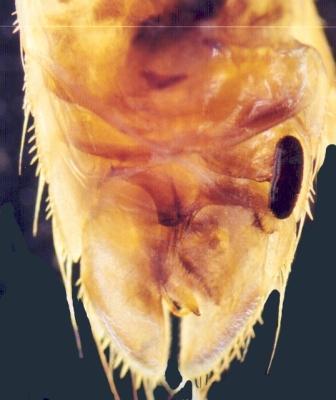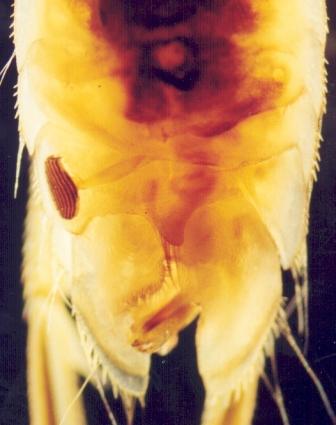Diptera.info :: Miscellaneous :: General queries
|
left-right body asymmetry
|
|
| Louis Boumans |
Posted on 04-09-2010 19:30
|
|
Member Location: NO Oslo Posts: 269 Joined: 09.06.04 |
In the mayfly genus Heptagenia, the nymphs have asymmetrical mandibles. One species has the asymmetry reversed relative to the other species. Its seems that the left-right body axis has swapped once This made me wonder about left-right asymmetry in Diptera. As far as I know, this occurs in the male genitalia of many higher flies. Are there examples of asymmetry in other body parts? Is there any information on such reversal of the body axis, either in species or occasionally in individuals? thanks for any suggestions! |
|
|
|
| atylotus |
Posted on 04-09-2010 20:07
|
|
Member Location: Amsterdam, NL Posts: 1172 Joined: 29.05.09 |
Dear Louis I do not exactly mean what you need to know but, In Corixidae (aquatic Heteroptera) the male has an assymetrical last abdominal segment and the genital capsule within is directed to either left or right position dependent on the genus. In the female the abdomen is symmetrical. Occasionaly however, in some individuals of a male species (for instance Sigara striata) a mirror-image occurs i.e species with a normal position of the genital capsule directed to the right (or left) had the capsule reversed to the left (or right). I have seen this on some occasions in Sigara striata and rarely in Corixa punctata. Also in the larva of some Trichoptera or (aquatic) Coleoptera species there is asymmetry in the mouthparts. But I think that asymmetry occurs in many species. If you mean if two sibling species has some part reversed, than I know of no species, but aberrant species of a normal species do occur (see above). |
|
|
|
| Louis Boumans |
Posted on 07-09-2010 20:41
|
|
Member Location: NO Oslo Posts: 269 Joined: 09.06.04 |
Hi Ton, thanks a lot! I quickly checked Google Scholar and saw there is some literature on asymmetry and reversed asymmetry in Corixidae. The basic questons are the same: how is the 'lateral identity' determined, how can it change? And in this case: does it affect mating success? |
|
|
|
| atylotus |
Posted on 08-09-2010 10:27
|
|
Member Location: Amsterdam, NL Posts: 1172 Joined: 29.05.09 |
Dear Louis I even discovered some old photo's taken by me in the early '90-s from a normal and an asymmetrical specimen of Sigara striata (also collected in the 1992-1994). I even noticed this mirror-image in Corixa punctata back then, but reversed. Ton atylotus attached the following image:  [19.12Kb] |
|
|
|
| atylotus |
Posted on 08-09-2010 10:28
|
|
Member Location: Amsterdam, NL Posts: 1172 Joined: 29.05.09 |
and the reversed male
atylotus attached the following image:  [19.37Kb] |
|
|
|
| Louis Boumans |
Posted on 13-09-2010 15:24
|
|
Member Location: NO Oslo Posts: 269 Joined: 09.06.04 |
Veel dank! This will help me iunderstand the Corixidae literature. What is the name of the bean-shaped sclerotised structure? |
|
|
|
| atylotus |
Posted on 13-09-2010 20:05
|
|
Member Location: Amsterdam, NL Posts: 1172 Joined: 29.05.09 |
This brown and stripes chitinized structure is called the "strigil" and in Sigara and many other genera it is placed at the right hand side. In Corixa it is on the left. The strigil is only present in males. The size of it is also diagnostic, in Sigara striata and only a few other species of another genus, it is large, in many other species is it smaller, usually rounded, In only one european species (not in NL) the males strigil is absent. |
|
|
|
| atylotus |
Posted on 14-09-2010 09:05
|
|
Member Location: Amsterdam, NL Posts: 1172 Joined: 29.05.09 |
The last sentence in my previous message needs some correction in short for the male NW- and Central-European Corixidae species: 1. strigil absent - genus Cymatia, Callicorixa, Paracorixa - strigil present....2 2. strigil on the left...Corixa (large strigil) - strigil on the right....3 3. strigil fairly large to large, its length at least halft the abdominal segment size.....Sigara striata, Hesperocorixa, Arctocorisa - strigil medium-sized to small, its length at most half the the abdominal segment size....other Sigara species and Glaenocorisa Offcourse there are more diagnostic features Edited by atylotus on 14-09-2010 09:06 |
|
|
|
| Jump to Forum: |












